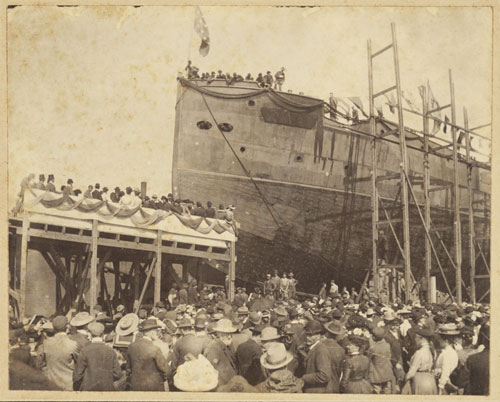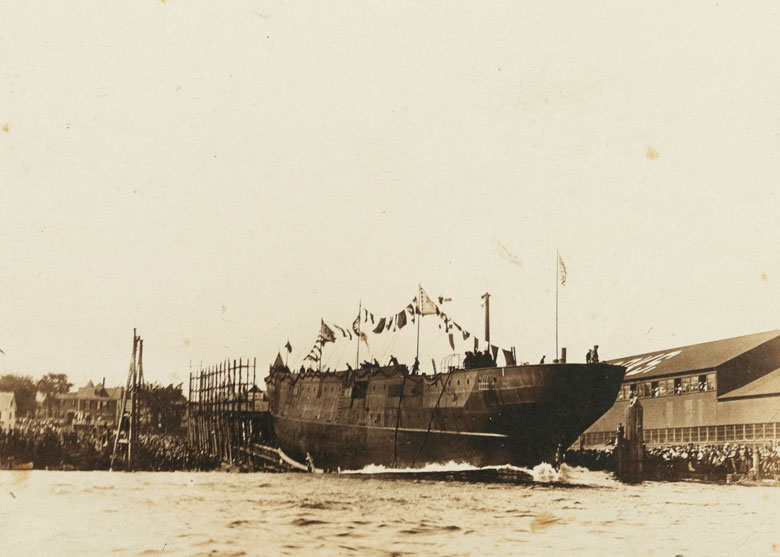
The launching of a new vessel is a dramatic spectacle and the first true test of its seaworthiness. This transition from land to water is a ritual-rich pageant, steeped in tradition, ceremony, and the potential for high drama. It’s a scene that has unfolded thousands of times in Maine waters, as ships of all types have made their maiden descent into water.
Getting a vessel into the water is no simple task.
Traditionally, ships are launched from slipways—a sloped platform leading into water where the vessel is built. The ship rests on keel blocks during construction, and its weight must be transferred to a cradle positioned on greased launching ways.
At the designated moment, a mechanism is released, and the vessel slides stern-first down the slipway, with water resistance slowing its descent. Once afloat, tugboats assist in stabilizing and guiding the ship to dock.
The accompanying images show the September 1901 launch of the USS Cleveland at Bath Iron Works. Spectators packed the yard, standing shoulder to shoulder among scaffolding and shipyard debris to witness the Navy cruiser’s christening and launch.
The act of christening draws from ancient rituals meant to ward off the dangers of the sea and ensure a ship’s safe passage.
These events were open to the public, though invited guests of the ship’s owner and builder received special privileges. They were allowed aboard during the launch and invited to a formal luncheon.
On the decorated platform, the ship’s sponsor, Ruth Hanna, ceremonially struck an ornately decorated bottle across Cleveland’s bow, declaring its name.
Sponsors are almost always women with a personal connection to the vessel’s namesake, builder, or owner. The act of christening draws from ancient rituals meant to ward off the dangers of the sea and ensure a ship’s safe passage. These customs have evolved across time and cultures, but all share a symbolic call for protection. The spilling of liquid represents a sacrificial offering—although during Prohibition, alcohol was often replaced with ginger ale or grape juice in many shipyards. An additional superstition lies in the renaming of vessels where it is considered bad luck not to re-christen a vessel with its new name.
The second image captures Cleveland’s smooth entry into the Kennebec River—an ideal outcome, but not always guaranteed. In Bath, there are accounts of grease overheating and melting, or improper ballasting causing vessels to list dramatically. One notable case involved a 684-foot freighter that came uncomfortably close to striking the Carlton Bridge.
As one of Maine’s oldest shipyards, Bath Iron Works has launched nearly 450 vessels into the Kennebec. Since 2001, however, the process has changed significantly.
With the construction of the land level transfer facility at the south end of the yard, ships are now built on a marine railway system and rolled into a dry dock, where they are floated. Though still fascinating, this method lacks the sudden, dramatic energy of a traditional launch.
Today, the physical act of launching is no longer part of the public celebration—but the christening ceremony still draws crowds, preserving a vital piece of maritime tradition.
Kelly Page is curator of collections at Maine Maritime Museum. Current special exhibitions include Upta Camp and Upon that Isle in Maine: The Story and Works of Chris Van Dusen.
Plan your visit and explore upcoming events at mainemaritimemuseum.org





